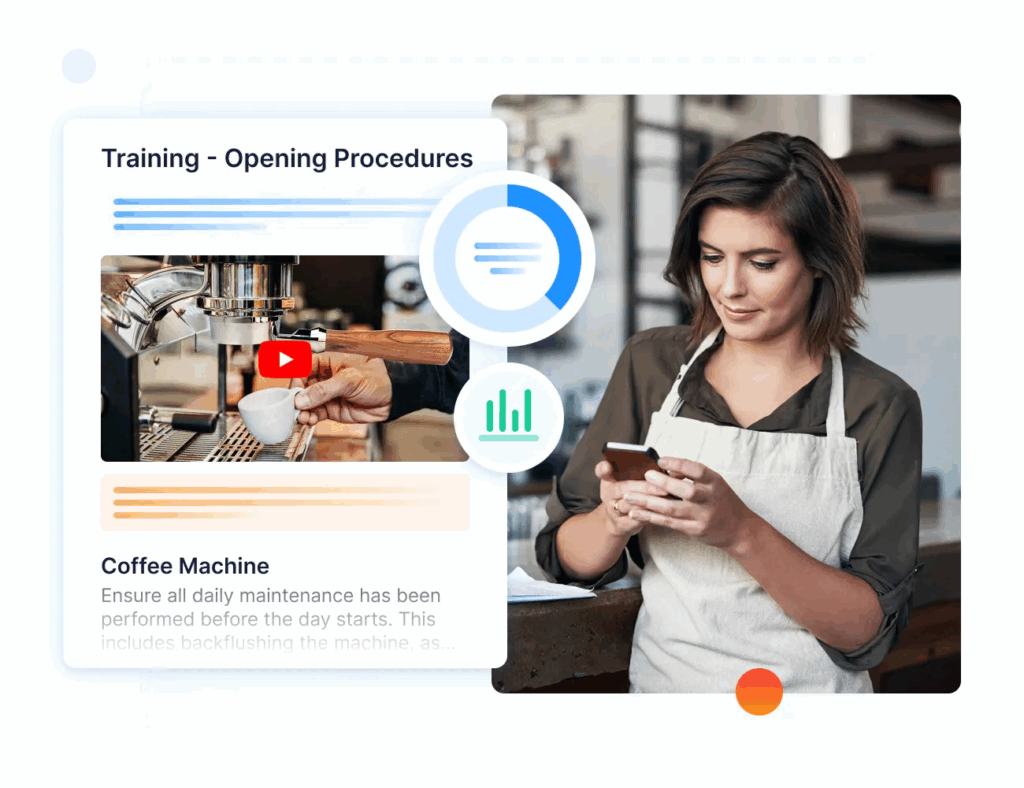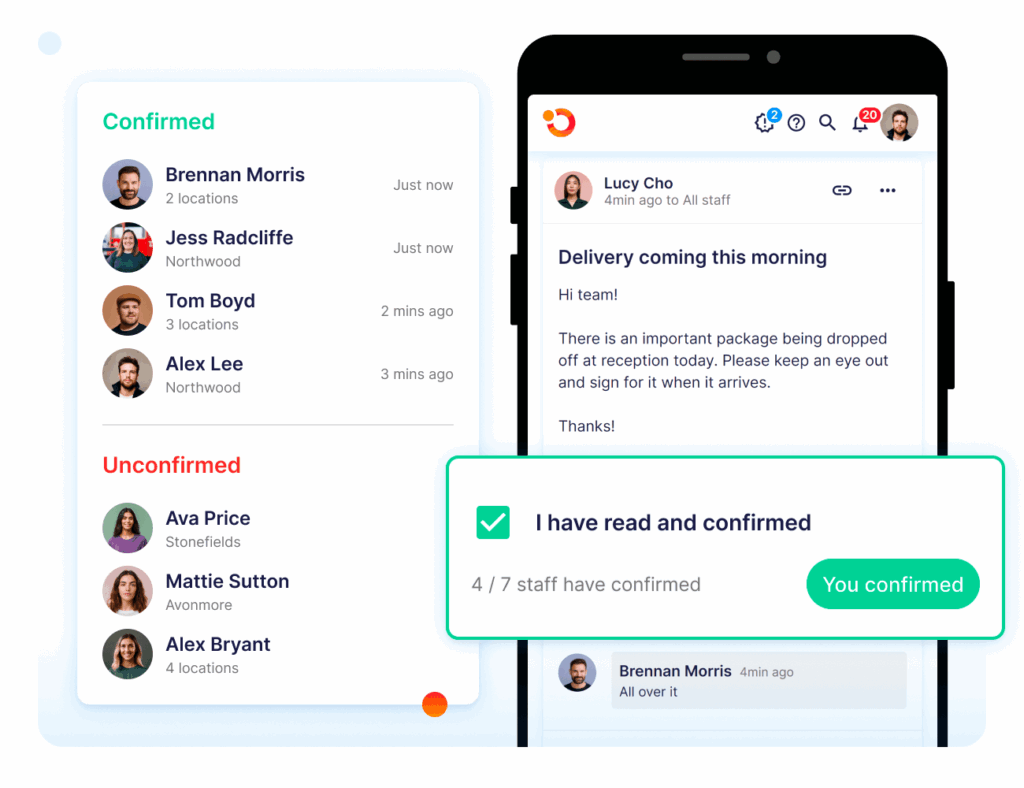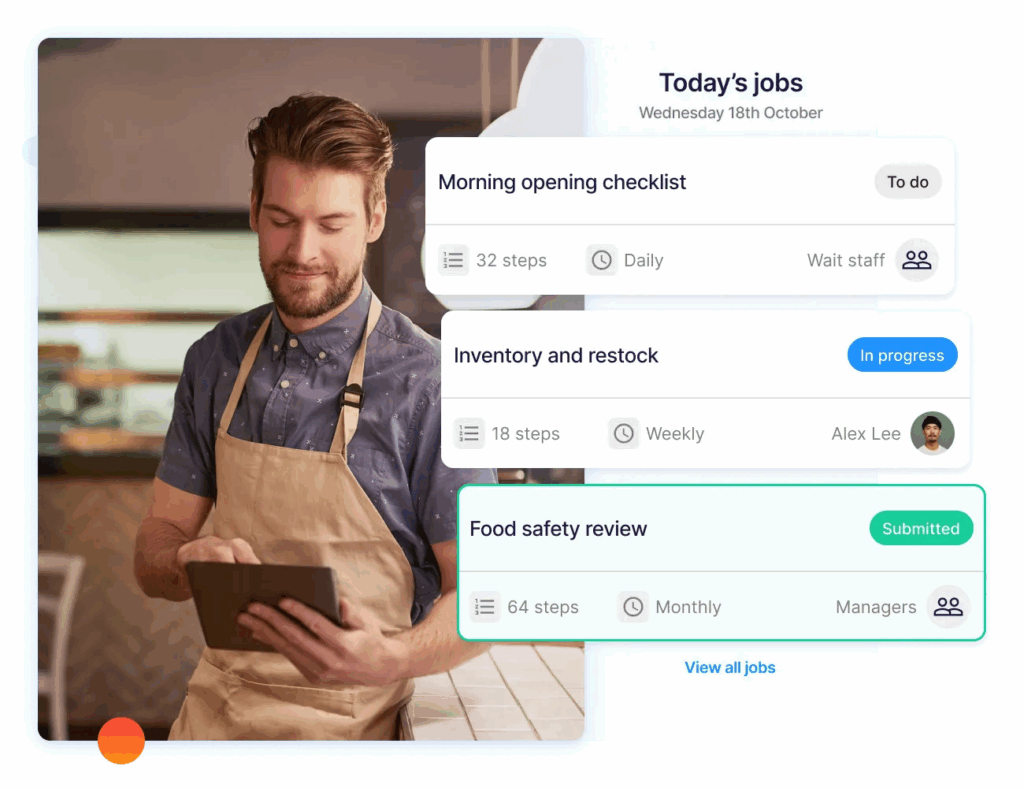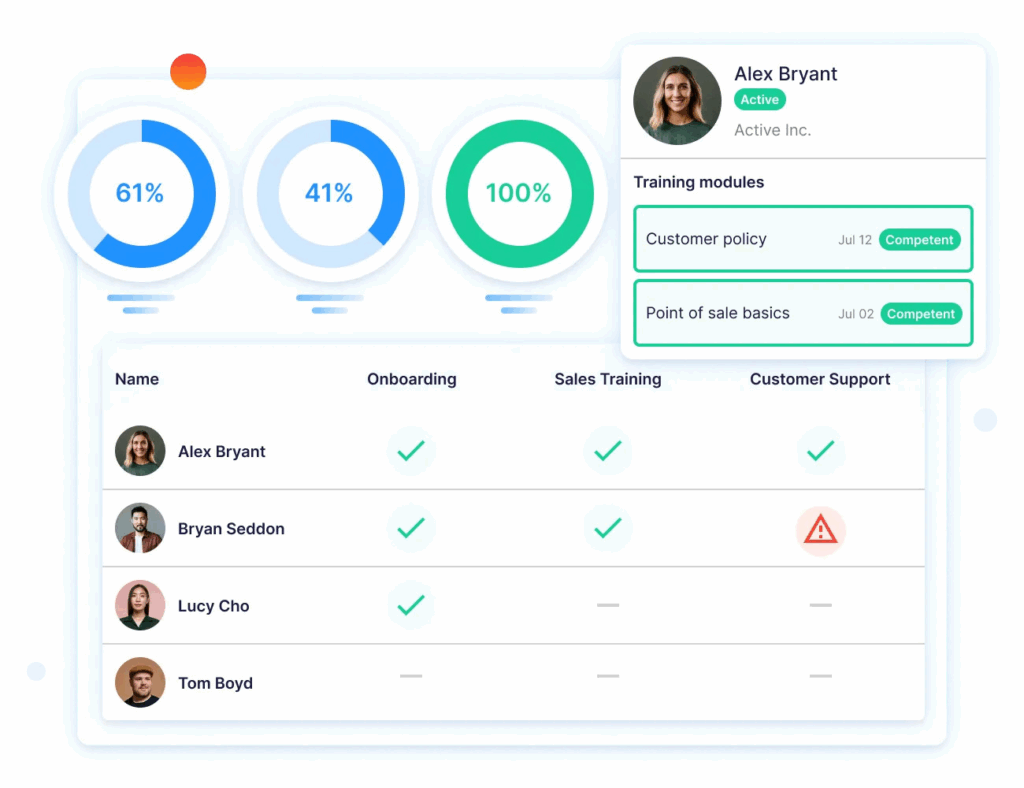How To Manage Restaurant Staff: 6 Tips & Strategies
Key Takeaways
- Effective restaurant staff management begins with clear communication, structured training, and fair schedules — this provides employees with clear standards and enhances engagement, retention, and performance.
- Senior managers who apply the right strategies and technology build a stronger culture, maintain compliance, and keep staff happy.
- Recognition programs and career development opportunities build a positive and motivated work environment.
- Restaurant employee management tools like Operandio automate tasks, provide LMS platforms, and streamline communication apps to ensure consistency across multiple units.
If you’ve just stepped into management or are running multiple franchise locations, the challenge remains the same: how to manage restaurant staff without burning them out.
The truth is, great senior restaurant managers aren’t born with the skill. They grow into the role through trials, experience, and proven playbooks.
The good news is you don’t need to learn everything the hard way. Instead of risking costly mistakes that hurt performance and profits, you can follow strategies that already work.
In this guide, you’ll discover practical ways to lead a restaurant team with confidence, reduce friction, and build a culture that keeps staff engaged and operations consistent.
Tips & Strategies To Manage Restaurant Staff
Here are the proven tips to help manage your restaurant staff:
Tip #1: Set Clear Expectations (Before Things Collapse)
Think about the new hire who looked perfect in the interview but turned into trouble two weeks later. Often, the problem isn’t just them.
Most breakdowns happen because no one explains what “good enough” means. No SOP exists. No knowledge base to guide them. So they assume “just enough” is fine.
So your first step is to:
- Document your restaurant’s operational standards.
- Create SOP documents and task management data.
- Define how fast tables should turn. Define what “clean” means at each station.
- And define the right way to handle a demanding customer.
Tip #2: Build a Communication System That Actually Works (Not Just More Meetings)
Your team are drowning in mixed messages, last-minute changes, and updates that never reach the right person.
Instead, create a system where updates reach everyone instantly, questions get answered quickly, and feedback flows both ways through a central communication hub.
Restaurant staff management gets easier when communication is consistent.
Tip #3: Make Schedules Fair (Even When It Feels Impossible)
You need coverage for that slow Tuesday lunch, but if you always assign the same employee who has a morning class or family duty, you lose their best effort — or worse, they walk out.
Use schedule software to spot patterns. Jennifer needs Sundays off to spend with her kids. Mark prefers late shifts because he’s a night owl. Align shifts with staff lives, not against them.
Fair doesn’t mean equal — it means respected. That respect creates a staff that not only shows up but actually cares.
Tip #4: Invest in Training (Like Your Business Depends on It)
Stop treating restaurant manager training as a cost. See it as the investment that decides whether your restaurant thrives or survives.
Because a well-trained employee will bring you more ROI — adhere to food safety compliance, and attend to customers better. Enhance customer satisfaction compared to an untrained employee.
But when you skip proper training, here’s what happens: new hires struggle, customers complain, veterans burn out covering gaps, and turnover spikes.
Tip #5: Give Recognition That Counts (Not Just Employee of the Month)
Employees want to feel seen. Recognition fuels motivation and loyalty.
Herzberg’s two-factor theory suggests that motivators, such as recognition and achievement, drive genuine satisfaction.
Your dishwasher, who stayed late on Saturday, deserves more than a quick “thanks.” Recognition hits hardest when it’s immediate, public, and specific.
“Thanks for staying late” is OK. “Thanks for jumping on prep when we fell behind — your hustle kept us from disappointing customers” is better.
People don’t quit jobs. They quit senior managers who ignore their efforts. Notice your team. Say it out loud.
Tip #6: Use Data to Stop Guessing (And Start Solving)
Track what matters: order accuracy, table turnover, satisfaction scores. Share the numbers with your team — not to blame, but to work together to solve them.
When facts guide decisions, fixes happen faster.
Restaurant employee management becomes easier when you stop guessing and start measuring.
Benefits of Strong Restaurant Staff Management
Here are the benefits of strong restaurant staff management:
Benefit #1: Increase Customer Retention
When Jessica took over at The Local Spot, turnover was out of control. “We were hiring someone new every week,” she recalls.
A year later, turnover dropped. “The secret wasn’t higher pay; it was showing people they mattered. When your best server sees you respect their class schedule, and your cook sees you notice their extra effort, they stay.”
Retention saves hiring costs and builds institutional knowledge.
Benefit #2: Consistency Across Locations
Multi-unit operators thrive when every location feels the same to guests. Strong restaurant staff management ensures consistent service, food quality, and safety standards. A senior manager told us, “Clear SOPs mean my New York store runs exactly like my LA store.” Consistency protects brand reputation and customer trust.
Benefit #3: Customers Notice the Difference
Guests pick up on everything. They notice that when staff appear happy, service flows smoothly, and orders arrive quickly and accurately.
Well-managed teams raise customer satisfaction because engaged employees deliver better service. Happy staff create happy guests — and happy guests return, spend more, and spread the word.
Benefit #4: Stronger Profits
Better staff management boosts profit. Lower turnover cuts hiring and training costs. Efficient teams turn tables faster and waste less. Happy customers come back and leave better reviews.
“Our profit margins jumped 15% in the first year,” says Tom, owner of four family restaurants. “We didn’t save by cutting costs. We saved by stopping waste from inefficiency and turnover. Labor costs went up slightly, but productivity soared.”
Training and Onboarding Best Practices for Staff

Best Practice #1: Start with Training Needs Assessments (Not Assumptions)
Your new server might have five years of experience, but do they know your POS system? Your prep cook might be fast with a knife, but do they understand your portion control standards?
Proper assessment prevents embarrassing situations where experienced workers appear incompetent because they are unfamiliar with your specific systems.
Best Practice #2: Use a Structured Training Program
New hires who undergo structured training are 40% more likely to stay past their first year.
Use tools like Operandio’s LMS to onboard staff with videos, quizzes, and checklists. This reduces ramp-up time and ensures staff meet compliance standards from day one.
Best Practice #3: Reinforce Training Continuously
Don’t treat training as a one-off. Reinforce lessons with refreshers, role-playing exercises, and visual aids. Employee training software helps managers push updates instantly when menus or compliance rules change. This prevents bad habits from sticking and keeps staff aligned with best practices.
Best Practice #4: Document Everything with Restaurant Training Manuals People Actually Use
Your training manual shouldn’t be a dusty binder that nobody reads. Create visual, easy-to-follow guides that people can reference quickly during shifts.
Excellent documentation supports your team instead of intimidating them. When people can quickly find answers to common questions, they perform better and feel more confident.
Leveraging Technology for Staff Management
Technology removes repetitive tasks and lifts efficiency. That’s why restaurant leaders must be tech-savvy.
Technology #1: Employee Communications Apps That Connect Your Team

Verbal conversations get forgotten. Group texts get messy. Bulletin boards get ignored. Email gets lost. These mode of communication limits your employees’ workflow.
Your team needs communication that works in the fast-paced restaurant environment.
But having a single communication hub, where every staff member receives live notifications and can easily track chat history, bridges the communication gap.
Technology #2: Digital Task Management That Actually Gets Things Done

How many times have you walked into your restaurant wondering if yesterday’s closing crew finished everything?
Task management systems eliminate that uncertainty by tracking what needs to be done, who’s responsible, and whether it’s actually completed.
Technology #3: Centralized Training Platforms

Instead of bulky manuals, provide a digital LMS where staff can access restaurant SOPs anytime. This reduces training errors and allows managers to track progress. For franchises, centralised training ensures consistency across the entire organisation.
Challenges in Staff Management and How to Solve Them
The difference between success and failure is having proven solutions ready before problems explode.
#1: The Revolving Door of Turnover
You just finished training someone who seemed perfect, and now they’re quitting with two days’ notice. Again. High turnover isn’t just expensive — it’s always challenging to start over.
The solution isn’t higher wages (though competitive pay helps) — it’s creating an environment where people want to stay.
Use employee onboarding checklists to ensure new hires feel welcomed and prepared. Implement stay interviews to understand why good employees leave and address issues before they escalate into resignations.
#2: Inconsistent Employee Performance
Your morning shift runs like clockwork, but your evening shift feels like amateur hour. Different managers, different standards, different results — and customers notice every inconsistency.
The answer is comprehensive restaurant training programs that work across all shifts and locations.
When everyone learns the same systems the same way, performance becomes predictable instead of random.
#3: Managing Multiple Locations (Without Losing Your Sanity)
Running one location is hard. Running several tasks multiplies the problems and makes it impossible to be everywhere. How do you keep standards and culture intact when you can’t be on-site?
Centralized systems and clear procedures provide oversight without micromanagement. With one dashboard for performance, communication, and compliance, management scales with you, rather than breaking you down.
Success Stories from Leading Restaurant Managers
These real-world examples demonstrate how innovative systems and technology transform restaurant operations and team management.
Scaling 52 Locations Without Losing Standards: Tex’s Chicken
When Tex’s Chicken expanded from one NYC storefront to 52 locations across the U.S., maintaining consistent restaurant staff management became their biggest challenge.
Each store was operating in silos, with managers interpreting processes differently and headquarters having limited visibility into daily operations.
“Once Operandio came in, it was the solution to all our problems. We can push standards to any store, any time,” explains Najib Ullah, Chief Operating Officer & Managing Partner at Tex’s Chicken.
The digital transformation delivered measurable results: 100% visibility into store-level compliance, 40% reduction in manager onboarding time, and brand consistency safeguarded across all locations. “Operandio is absolutely amazing, 10 out of 10,” Ullah reports.
Unifying Operations Across Multiple Brands: LUCAS Restaurants
LUCAS Restaurants operates nine venues, including Chin Chin, Kisumé, and Baby Pizza, across Melbourne, Sydney, and Canberra. Managing multiple brands meant balancing each venue’s unique identity with the need for consistent standards across all venues.
The group struggled with paper-heavy food safety records, slow reporting to head office, and accountability gaps across locations.
By moving to a centralized task management system with brand-specific workflows, they digitized food safety, streamlined reporting, and automated labeling. Each restaurant kept its character while the group achieved consistency, compliance, and efficiency across the board.
How Operandio Simplifies Staff Management
Operandio provides the tools senior managers need to succeed — from training assessments to employee communications apps and digital training manuals.
With Operandio, you can standardize onboarding, ensure compliance, and keep staff accountable in one powerful platform.
Ready to simplify restaurant staff management?
Request a Demo and discover how the best restaurant managers are transforming their biggest headache into their most significant competitive advantage.


